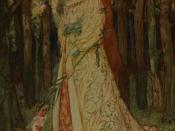In John Keats's ballad "La Belle Dame sans Merci" the author writes of a world-weary knight-at-arms standing by a withered, dying lake pining after the love he thinks he lost. The author writes mostly with a tone of high enthusiasm, almost giddiness, until after the climax, when the poem takes a dark turn. "La Belle Dame sans Merci" proves that beauty is in the eye of the beholder, and that unrequited love as shown by the knight is not always well received.
Keats writes in a style that makes the poem seem like a story: he starts with one speaker, a traveler who is roaming the land and happens upon a figure "Alone and palely loitering," which I took to mean the knight is by himself and very pale, typical of a ghost. This ghost-knight is standing by a lake from which "The sedge and withered .
. . And no birds sing!" This shows that the lake is almost completely devoid of life; at least from the traveler's viewpoint. No trees grow around the lake, and no wildlife is to be seen anywhere. The first stanza is devoted to setting the tone and location of the poem, along with determining the state of the knight, or ghostly.
In the second stanza, we learn that the knight is suffering from something, although we cannot tell what it is just yet. The traveler sees him as "So haggard, and so woebegone" meaning the knight has been standing at the lakeside for a long time, and is unshaven and unhappy. The last two lines set the season, with the lines "The squirrel's granary is full And the harvest's done" meaning the time of year is late autumn, when animals have finished preparing for hibernation and humans have...


